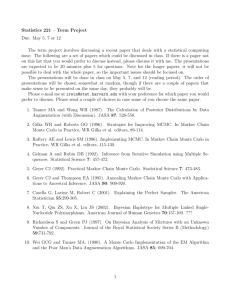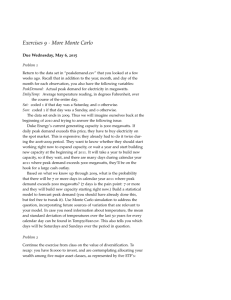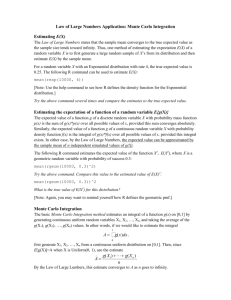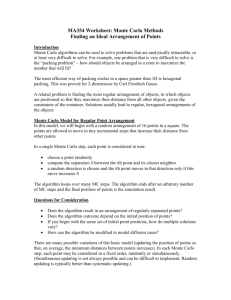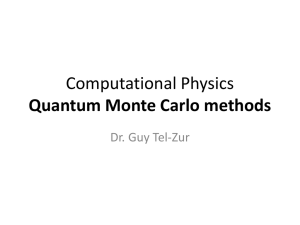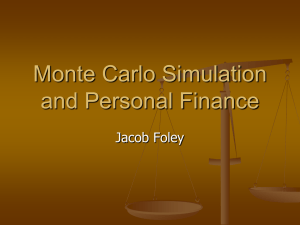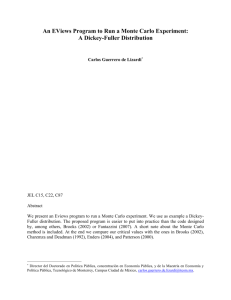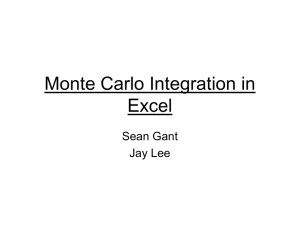Policy Evaluation
advertisement
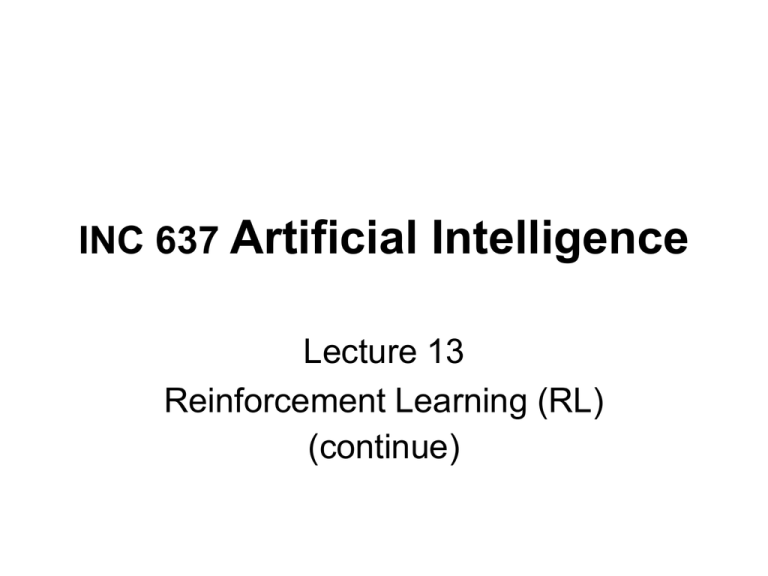
INC 637 Artificial Intelligence Lecture 13 Reinforcement Learning (RL) (continue) Reinforcement Learning Value Table Action State 3 2 3 2 4 22 3 4 State Value Table 1 dimension (V-table) 2 4 3 7 66 9 4 43 7 State 9 45 3 6 4 6 7 8 5 : : : 6 4 7 7 7 5 8 7 9 : 8 6 4 3 4 3 9 3 11 54 6 4 8 0 8 56 5 46 8 : : : 9 6 6 6 7 6 5 4 5 : 4 Action Value Table 2 dimension (Q-table) Bellman Equation for a Policy p คำนวณหำ Value Function จำก policy π Rt rt 1 rt 2 2 rt 3 3 rt 4 rt 1 rt 2 rt 3 rt 4 2 rt 1 Rt 1 So: V p (s) Ep Rt st s Ep rt 1 V st 1 st s Or, without the expectation operator: V (s) p (s,a) PssRss V ( s) p a a s a p Bellman Optimality Equation for V* The value of a state under an optimal policy must equal the expected return for the best action from that state: p V (s) max Q (s,a) aA(s) max Ert 1 V (st 1 ) st s, at a aA(s) max PsasRsas V (s) aA(s) s 3 Methods to find V* • Dynamic Programming • Monte Carlo • Temporal Difference Dynamic Programming ประกอบด้ วยขบวนกำรหลัก 2 ส่ วน Policy Evaluation Policy Improvement Policy Evaluation p Be ll man e qu ati on for V : V (s) p (s,a) PssRss V ( s) p a a a p s — a system ofS sim ultaneous linear equat ions แต่ ละ state มีสมกำรของตัวเองซึ่งขืน้ กับ value function ของ next state เป็ นสมกำร linear หลำยตัวแปร อย่ ำงไรก็ตำม ก็ยงั ยำกทีจ่ ะแก้ สมกำรถ้ ำมีหลำยๆ state Iterative Policy Evaluation V0 V1 Vk Vk 1 V p a “sweep” A sweep consists of applying a backup operation to each state. ตือใช้ value function จำก อันก่ อนมำประมำณอันปัจจุบนั A full policy evaluation backup: Vk 1 (s) p (s,a) PssRss Vk (s) a a s a Example Terminal state Terminal state • Undiscounted episodic task • Actions that would take agent off the grid leave state unchanged • Reward is –1 for every action until the terminal state is reached (0.25(-1+0.0) + 0.25(-1-1.0) + 0.25(-1-1.0) + 0.25(-1-1.0) Policy Improvement สำมำรถทำได้ จำก value function ทีค่ ำนวณได้ มำโดยปรับ ให้ ไปเลือก action ทีม่ ี value function สู งสุ ด p(s) argmaxQp (s,a) a argmax Psas Rsas V p (s) a s เรียกว่ ำเป็ น greedy actions Then V p V p What ifVp Vp ? i.e., for alls S, V p(s) max PsasRsas Vp (s ) ? a s But this is the Bellm an Opt imality Equat ion. So V p V and bot hp and pare opt imal policies. Iterative Policy Improvement p0 V p0 p1 p1 V policy evaluation p V p * * policy improvement “greedification” กำร estimate ค่ ำ value function โดยใช้ ค่ำ estimate ของมันเองเรียก Bootstrapping * Dynamic Programming Monte Carlo Method Dynamic Programming ต้ องรู้ world model นั่นคือมี reward เท่ ำใด ทีไ่ หมบ้ ำง และ next state เป็ นอะไร Monte Carlo จะไม่ ต้องรู้ world model มำก่ อน คุณสมบัติของ Monte Carlo • ใช้ ได้ กบั episodic tasks เท่ ำนั้น • learn จำก ประสบกำรณ์ จริงโดยใช้ complete returned reward Monte Carlo Policy Evaluation • Goal: learn Vp(s) • Given: some number of episodes under p which contain s • Idea: Average returns observed after visits to s 1 2 3 4 5 • Every-Visit MC: average returns for every time s is visited in an episode • First-visit MC: average returns only for first time s is visited in an episode • Both converge asymptotically Backup Diagram of MC • Entire episode included • Only one choice at each state (unlike DP) s1 a1 s2 a2 • MC does not bootstrap s3 a3 • Time required to estimate one state does not depend on the total number of states Series of actions Monte Carlo Policy Iteration Qp k (s, p k 1 (s)) Qp k (s,argmaxQp k (s,a)) a maxQp k (s,a) a pk Q (s,p k (s)) pk V (s) Policy Improvement Example: Blackjack • Object: Have your card sum be greater than the dealers without exceeding 21. • States (200 of them): – current sum (12-21) – dealer’s showing card (ace-10) – do I have a useable ace? • Reward: +1 for winning, 0 for a draw, -1 for losing • Actions: stick (stop receiving cards), hit (receive another card) • Policy: Stick if my sum is 20 or 21, else hit เช่ นในสถำนะกำรหนึ่งไม่ มี usable ace และ เจ้ ำมือ show 8 เรำเริ่มต้ นที่ แต้ ม = 12 จั่วได้ เป็ น 14 และ 18 แล้ วดูผลว่ ำแพ้ หรือชนะ จะนำค่ ำผลลัพธืทไี่ ด้ มำ update state ที่ 12, 14, 18 นี้ ทำไปหลำยหมืน่ ครั้งจะได้ กรำฟของทุก state ดังรูป Temporal Difference (TD) Policy Evaluation (the prediction problem): p for a given policy p, compute the state-value function V Recall: Simple every- visit Mont e Carlomethod: V(st ) V(st ) Rt V (st ) target: the actual return after time t T he simplest T D method, T D(0): V(st ) V(st ) rt 1 V (st1 ) V(st ) target: an estimate of the return Simple Monte Carlo V(st ) V(st ) Rt V (st ) where Rt is the actual return following st ate st . st T T T TT T TT T TT T TT T Simplest TD Method V(st ) V(st ) rt 1 V (st1 ) V(st ) st rt 1 s t 1 TT T T T TT T T TT T TT T Dynamic Programming V(st ) Ep rt 1 V(st ) st rt 1 T TT TT T T T T T T s t 1 T TD Bootstraps and Samples • Bootstrapping: update involves an estimate – MC does not bootstrap – DP bootstraps – TD bootstraps • Sampling: update does not involve an expected value – MC samples – DP does not sample – TD samples Learning an Action-Value Function Est im at eQp for the current behavior policy p. After every transit ion from a nonterminal st st ,atdo e t his: Qst , at Qst , at rt 1 Qst 1 ,at 1 Qst ,at If st 1 is term inal,t henQ(st 1, at 1 ) 0. Sarsa: On-Policy TD ทีเ่ ป็ น on-policy เพรำะต้ องทำ action ก่ อนเพือ่ ให้ ได้ next state แล้ วค่ อยนำมำ update value table Q-learning Off-Policy TD One- step Q- learning: Qst , at Qst , at rt 1 maxQst1 , a Qst , at a ทีเ่ ป็ น off-policy เพรำะไม่ ต้องทำตำม next state ทีจ่ ะเลือกเอำ action ทีไ่ ด้ reward สู งสุ ด Current state 0.9 Action ไปทำงขวำ Next state




